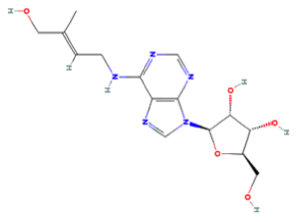
Zeatin Riboside is an organic chemical compound with the molecular formula is molecular formula. Zeatin Riboside is solid and soluble in water, ethanol, and methanol.
Scientists at Creative Proteomics utilize a highly quantitative method with high-performance liquid chromatography (HPLC) for the determination of Zeatin Riboside levels in various samples, including Plant, Tissue and more. High-Performance Liquid Chromatography (HPLC) with UV detection is used for the determination of Zeatin Riboside (254 nm) levels in a lot of biological samples. This Methodology provides accurate, reliable, and reproducible results of Zeatin Riboside measurement, which enables us to analyze of Zeatin Riboside levels in vitro and in vivo.
Zeatin Riboside is the most active and ubiquitous form of the naturally occurring cytokinins, which can promote ell division, stimulate shoot proliferation, inhibit root formation slow the aging process, and activate gene expression and metabolic activity generally. Natural cytokinin hormone levels are high during maximum growth periods in the mature plants. The combination of cytokinins and auxin, which is another plant growth hormone, plays an important role in the effect of cytokinin on plant growth. When cultured with cytokinin but no auxin, cytokinin alone has no effect on parenchyma cells. When cultured with auxin alone, the parenchyma cells grow large but do not divide. The cells expand and differentiate after adding the cytokinin. The parenchyma cells form an undifferentiated callus when cytokinin and auxin are present in equal levels in the culture medium. More cytokinin can induce the growth shoot buds and more auxin can induce the formation of root. The concentration of Zeatin Riboside varies largely during different stages of development. Zeatin Riboside can be added into the plant cell culture medium to study its effects on the plants development and root formation in the different development stage.
The Russian-Polish botanist M. Tswett is generally recognized as the first person to establish the principles of chromatography. In a paper he presented in 1906, Tswett described how he filled a glass tube with chalk powder (CaCO3) and, by allowing an ether solution of chlorophyll to flow through the chalk, separated the chlorophyll into layers of different colors. He called this technique “chromatography”. Fundamentally, chromatography is a technique used to separate the components contained in a sample. High Performance Liquid Chromatography (HPLC) is a method able to separate non-volatile, thermally unstable, and polar components separate or in a mixture. HPLC is a type of chromatography that, because of its wide application range and quantitative accuracy, is regarded as an indispensable analytical technique, particularly in the field of organic chemistry. It is also widely used as a preparation technique for the isolation and purification of target components contained in mixtures.
Zeatin Riboside Analysis Service at Creative Proteomics supports your research in Zeatin Riboside Analysis. HPLC Based Analysis Service Platform enable us at Creative Proteomics offers you a state-of-the-art Analysis Service.
Sample Type
Plant, Tissue and more
Method
High-Performance Liquid Chromatography (HPLC) with UV detection is used for the determination of Zeatin Riboside (254 nm) levels in a lot of biological samples. This Methodology provides accurate, reliable, and reproducible results of Zeatin Riboside measurement, which enables us to analyze of Zeatin Riboside levels in vitro and in vivo.
Send us your samples, you will get all information that you need!







